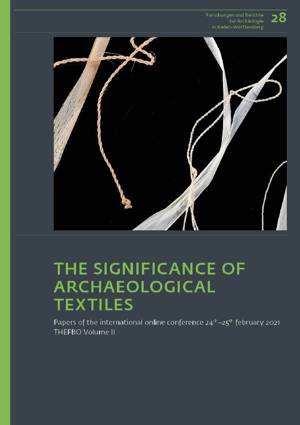
- Afhalen na 1 uur in een winkel met voorraad
- Gratis thuislevering in België vanaf € 30
- Ruim aanbod met 7 miljoen producten
- Afhalen na 1 uur in een winkel met voorraad
- Gratis thuislevering in België vanaf € 30
- Ruim aanbod met 7 miljoen producten
Zoeken
The Significance of Archaeological Textiles
Papers of the International Online Conference 24th-25th February 2021. Thefbo Volume II
€ 41,45
+ 82 punten
Omschrijving
The everyday utensils of prehistoric agricultural settlements were, to a large extent, textile products. Functional textiles were used in everyday subsistence and helped the settlements' inhabitants carry out tasks that were indispensable in the context of a sedentary lifestyle. In this context, the question arises as to what extent sedentariness would have been possible without textiles, simply because there is no other material that is as versatile as textile raw material. This particular topic was part of the joint project "THEFBO: Textile craftsmanship in the prehistoric wetland settlements on Lake Constance and Upper Swabia - requirements for textiles and their perception". The project was funded by the German Federal Ministry of Education and Research from 2019 to 2021 and coordinated by the Landesamt fur Denkmalpflege im Regierungsprasidium Stuttgart. Results of the project will be presented in THEFBO volume I / Forschungen und Berichte zur Archaologie in Baden-Wurttemberg 27. Part of this project was an online conference from 24th-26th February 2021, the proceedings of which are presented in THEFBO volume II. It dealt with textile findings and raw materials from a dendrological, paleobotanical, textile-archaeological and cultural-historical perspective. The broad spectrum of topics gave insights into the wide range of technical textiles in prehistory. Some of the oldest and most outstanding textile finds such as early Holocene tree bast strings, ropes, and nets from Friesack 4 in Brandenburg or the strings and bags from the wells of the Early Neolithic Linear Pottery Culture were presented and discussed at the conference. Other case studies considered Neolithic basketry and cordage in the Iberian Peninsula, Neolithic and Bronze Age textiles and tools from Northern Italy, textile tools and imprints on clay sealings from Bronze Age Greece to prehistoric objects made of plant fibres and wool from ice patches in the Bernese Alps, Switzerland. Contributions discussing the distribution of Lime trees (Tilia spec.) in prehistoric European landscapes, experimental approaches to manufacturing prehistoric threads or aspects of textile terminology completed the conference.
Specificaties
Betrokkenen
- Uitgeverij:
Inhoud
- Aantal bladzijden:
- 208
- Taal:
- Engels
- Reeks:
- Reeksnummer:
- nr. 28
Eigenschappen
- Productcode (EAN):
- 9783752007848
- Verschijningsdatum:
- 23/01/2024
- Uitvoering:
- Hardcover
- Formaat:
- Genaaid
- Afmetingen:
- 215 mm x 15 mm
- Gewicht:
- 494 g

Alleen bij Standaard Boekhandel
+ 82 punten op je klantenkaart van Standaard Boekhandel
Beoordelingen
We publiceren alleen reviews die voldoen aan de voorwaarden voor reviews. Bekijk onze voorwaarden voor reviews.










